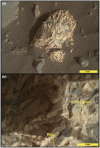Askival: An altered feldspathic cumulate sample in Gale crater
- PMID: 37082523
- PMCID: PMC10108227
- DOI: 10.1111/maps.13933
Askival: An altered feldspathic cumulate sample in Gale crater
Abstract
Askival is a light-toned, coarsely crystalline float rock, which was identified near the base of Vera Rubin Ridge in Gale crater. We have studied Askival, principally with the ChemCam instrument but also using APXS compositional data and MAHLI images. Askival and an earlier identified sample, Bindi, represent two rare examples of feldspathic cumulate float rocks in Gale crater with >65% relict plagioclase. Bindi appears unaltered whereas Askival shows textural and compositional signatures of silicification, along with alkali remobilization and hydration. Askival likely experienced multiple stages of alteration, occurring first through acidic hydrolysis of metal cations, followed by deposition of silica and possible phyllosilicates at low T and neutral-alkaline pH. Through laser-induced breakdown spectroscopy compositional analyses and normative calculations, we suggest that an assemblage of Fe-Mg silicates including amphibole and pyroxene, Fe phases, and possibly Mg-rich phyllosilicate are present. Thermodynamic modeling of the more pristine Bindi composition predicts that amphibole and feldspar are stable within an upper crustal setting. This is consistent with the presence of amphibole in the parent igneous rocks of Askival and suggests that the paucity of amphiboles in other known Martian samples reflects the lack of representative samples of the Martian crust rather than their absence on Mars.
© 2022 The Authors. Meteoritics & Planetary Science published by Wiley Periodicals LLC on behalf of The Meteoritical Society.
Figures













References
-
- Anderson, R. B. , Clegg, S. M. , Frydenvang, J. , Wiens, R. C. , McLennan, S. , Morris, R. V. , Ehlmann, B. , and Dyar, M. D. 2017. Improved Accuracy in Quantitative Laser‐Induced Breakdown Spectroscopy Using Sub‐Models. Spectrochimica Acta Part B: Atomic Spectroscopy 129: 49–57.
-
- Bandfield, J. L. 2002. Global Mineral Distributions on Mars. Journal of Geophysical Research: Planets 107: 9‐1–9‐20.
-
- Bedford, C. , Schwenzer, S. P. , Bridges, J. C. , Banham, S. , Wiens, R. C. , Gasnault, O. , Rampe, E. , Frydenvang, J. , and Gasda, P. J. 2020. Geochemical Variation in the Stimson Formation of Gale Crater: Provenance, Mineral Sorting, and a Comparison with Modern Martian Dunes. Icarus 341: 113622.
-
- Bedford, C. C. , Bridges, J. C. , Schwenzer, S. P. , Wiens, R. C. , Rampe, E. B. , Frydenvang, J. , and Gasda, P. J. 2019. Alteration Trends and Geochemical Source Region Characteristics Preserved in the Fluviolacustrine Sedimentary Record of Gale Crater, Mars. Geochimica et Cosmochimica Acta 246: 234–66.
-
- Berger, G. , Toplis, M. J. , Treguier, E. , d'Uston, C. , and Pinet, P. 2009. Evidence in Favor of Small Amounts of Ephemeral and Transient Water During Alteration at Meridiani Planum, Mars. American Mineralogist 94: 1279–82.
LinkOut - more resources
Full Text Sources
Miscellaneous
